The American Association of Physicians of Indian Origin (AAPI) organized the 75th Anniversary of the Independence of India/Azadi Ka Amrit Mahotsav on Capitol Hill on Wednesday, September 21st, 2022, where key US Senators and Congressmen participated and stressed the need to strengthen Indo-US relationship and praised the contributions and achievements of Physicians of Indian Origin and the larger Indian American community.
A strong India means a strong US, influential US lawmakers from both sides of the aisle said, as they pledged to work towards strengthening the relationship between the two largest democratic countries of the world at a time when the world is undergoing several changes and facing numerous challenges. Attended by dozens of leaders of AAPI and several community leaders, a first of its kind, the India Day on Capitol Hill was a celebration of India as a nation that is a model and strong democracy and a fast-growing economy that has taken a central place on world stage.
Dr. Sampat Shivangi, Chair of AAPI Legislative Committee, who has played a lead role in organizing the India Day celebrations on Capitol Hill said, Indian-Americans have a key role to play in the India-US relationship. “It is a proud moment for every Indian, living in every part of the world to see the progress that our motherland has achieved since its independence 75 years ago.” Dr. Shivangi, a member of the National Advisory Council, Center for National Mental Health Services referred to India which has now become the fifth largest economic superpower in the world even surpassing India’s Colonial Masters, the UK, France, and Germany.
Quoting a White House Press Release last month, Dr. Shivangi said, “The QUAD agreement is a testimony of this the role for the promotion of human freedom and dignity, and ways to restrain the Chinese expansionism that is not respecting international laws, friendships, and relationships. “The United States sees India as an indispensable partner and confident in a relationship the two countries are pursuing their own national interests in Ukraine. The US-India strategic partnership is grounded in their commitments to the advancement of the free and open Indo-Pacific region.”
In his welcome address, Dr. Ravi Kolli, President of AAPI, “India @ 75! It is a milestone filled with feelings of sense of pride and joy for all the accomplishments and progress we have made, while preserving our integrity, unity, core values of freedoms, democracy and respect for diverse cultures and the groups that live and thrive in our beloved motherland. India has made great strides in various sectors of economy lifting over 270 million out of poverty in the past decade or so.
Referring to the unprecedented growth of India, Dr. Kolli said, “It is the 5th largest economy in the world. In 1947 Maternal Mortality Rate was 2,000 for 100,000 births and Infant Mortality rate was 150 and now MMR is 150 and IMR is 27.6 in 2021. In the higher education sector India now has 1,043 universities and 42,000 colleges vs 27 universities and 578 colleges in 1950 and literacy rate is close to 75 % now as opposed to 20% in 1950. The number of medical colleges grew from mere 28 in 1950 to over 612 now in 2022. These accomplishments by themselves are worthy of a grand celebration, but India accomplished all this progress as a thriving democracy, with its steadfast commitment to freedoms with equity and inclusion of all faiths and creeds is a remarkable success story to be cherished and shared. We are proud to be part of this historic celebration of India on Capitol Hill, where we will have an opportunity to exchange views and express our concerns with the dozens of US Lawmakers, who will come to be part of the celebrations.”
“I am here today to say, thank you, from the bottom of my heart,” Senator Joe Manchin, a West Virginia Democrat said. Recalling his visits to India, he said, he saw in action “the greatness of the largest democracy in the world in full action.” While lauding the contributions of physicians of Indian Origin, “Had it not been for the Indian community that came to West Virginia to provide their services, most of rural West Virginia would not have health care today.” While observing that a major section of healthcare service in the rural US is provided by Indian American Doctors.
Senator Cindy Hyde-Smith, a Republican Senator representing the state of Mississippi stressed the importance of having strong relations between India and the United States. “The relationship between the United States and India is mutually beneficial for both of the countries and not just in the field of medicine and technology,” she said.
Senator Shelley Capito from West Virginia noted how the Indian American community is playing a key role in enriching the cultural experience of her state. “I live in Charleston, West Virginia, a small rural state. If we did not have any Indian American doctors, we would not have any kind of quality healthcare, we would not have the breadth and the depth and the richness of our communities that we have,” she said.
India’s Ambassador to the US Hon. Taranjit Singh, in his keynote address said that there is a close connection between the two countries and today it is driven by the leadership of the two largest democracies of the world. Indian American doctors have an especially key role to play in the India-US relationship, Sandhu said. “India today is one of the fastest-growing, major, emerging economies in the world,” he said. “We have such a vibrant and dynamic Indian American community represented in this country. The success of the Indian American community as professionals – doctors, technocrats, scientists and, entrepreneurs, has been an inspiration to many of us in India. And today, support of this community is vital to us” in forging a much stronger relationship with the US.
India and United States enjoy a comprehensive global strategic partnership covering almost all areas of human endeavor, driven by shared democratic values, convergence of interests on a range of issues, and vibrant people-to-people contacts, he said. Referring to the fact that within one month’s period, more than half a dozen senior Indian Ministers are visiting the US and a similar visit would happen from the US to India, he said. “This is a reflection of the relationship between India and the United States,” he pointed out.
Congressman Joe Wilson, a GOP lawmaker and co-chair of Indian Caucus in Congress, shared about his fond memories with India, going back to the days when his dad served in India during the World War. India and America – nations which respect individuals, freedom, human dignity, private property, and believe in free markets – have the potential to build on shared values, he said. “India has a major role to play in world peace, stabilizing world,” he added.
Rep. Michael Guest from Mississippi’s 3rd Congressional District, said, “We are so blessed to have you. I want to thank you for coming to the US from a great civilization.” Lauding the great contributions of AAPI fraternity, he said, “You reach out to when people are in crisis. You put yourself in arms way to serve your fellowmen, to serve others, especially during Covid.” Describing Indo-US partnership as “strategic relationship” the Congressman said, “We work together to protect freedom and democracies. We work together for the greater good of humanity.”
Indian American Congressman Ro Khanna from the California said, “US India relationship is more critical than ever for the world.” He said, “India should not be subject to (CAATSA) sanctions because of its historic relationship with Russia.” Praising the recent messaging of Prime Minister Narendra Modi to the Russian leadership, Khanna said India can play a critical role in a peaceful resolution of the Ukrainian conflict. He referred to Prime Minister Narendra Modi, who met Vladimir Putin last week on the sidelines of the 22nd meeting of the Shanghai Cooperation Organization in Uzbekistan’s Samarkand, had told the Russian leader that “today’s era is not of war.”
Rep. Pramila Jayapal, the first and only Indian-American woman in the US Congress, said India and the US, despite being a world apart, have shared a very unique and important relationship over the years. India and the US have made tremendous strides in the promotion of public health. With the help of more than USD 200 million in aid from the US, India surpassed an important milestone in the fight against COVID-19 by administering two billion doses of vaccines, the second most of any country in the world, she said.
Congressman Raja Krishnamoorthi said the Indian American community needs to make its presence known. Imploring more Indian Americans to run for office, Krishnamoorthi told the Capitol Hill gathering, “If you are not at the table, you will be on the menu.” India, he said, has done a lot in the last 75 years. “I want to talk a little bit about its (India’s) greatest export. Its greatest export is you – Indian Americans who are four million strong. They are the fastest-growing ethnic minority in America. They are the most prosperous ethnic minority and the most well educated.”
Congressman Ted Deutch said, India and the US are strategic partners and Indian Americans are the key assets in the India-US relationship. “We are not only strategic partners, but we are friends,” he said. Referring to the NRI community, he said, “This is the group in the US, of all the ethnic groups, with the highest income and the highest level of education.”
U.S. Congressman Pat Fallon (TX-04), who had attended both the Capitol Hill event as well as at the Embassy Reception compared India and the United States, as both have gained independence from Britain. Both are today the greatest democracies of the world, he said and added that India at 75th anniversary of Independence Day is doing better and greater than how the US did at its 75th anniversary. Lauding the contributions of Indian American Physicians and the larger Indian American community Rep. Fallon highlighted the strong and strategic relationship the United States and India have, that benefits not only the two nations, but the entire world.
“Indian American physicians have made vital contributions to the health care field,” said Dr. Kishore Challa, Co-Chair of AAPI’s Legislative Committee. “As physicians, we provide critical care to patients from rural & urban communities across the Country. Indian American doctors are playing a critical role in filling the nationwide physician shortage. The India Day on Capitol Hill is a unique opportunity for AAPI members to be part of the decision-making process on matters related to healthcare and advocate for stronger and closer ties between India and the United States.”
Dr. Anjana Samadder, President-Elect of AAPI said, “AAPI has been serving India and contributing to the effective healthcare delivery in the US and in India. In keeping with the mission of AAPI, the celebrations on the Hill provided us with a forum to facilitate and enable Indian American physicians share our concerns with the Lawmakers in pursuit of our aspirations in matters relating to professional and community affairs.”
“The historic 75th India Independence Day celebrations on Capitol Hill was an effective Forum to help renew our friendship with US administration under the leadership of President Joe Biden and Vice President Kamala Harris and brief the Congressional leaders on issues that are important to us,” said Dr. Satheesh Kathula, Vice President of AAPI.
“AAPI’s India Day celebrations on Capitol Hill helped members rekindle and renew our energy in bringing up the issues to the attention of national policymakers and leaders of the US Congress on Capitol Hill,” said Dr. Sumul Rawal, Treasurer of AAPI.
A reception and dinner hosted by Honorable Taranjit Singh Sandhu, Ambassador of India to the United States, with several dignitaries at the Indian Embassy was the grand finale to the day-long event at the nation’s capital. India and United States enjoy a comprehensive global strategic partnership covering almost all areas of human endeavor, driven by shared democratic values, convergence of interests on a range of issues, and vibrant people-to-people contacts. “The relationship is very strong,” noting India and the US are connected in culture, democratic traditions, entrepreneurship, and innovation. “And we are connected because the Indian American community in the US is so very strong,” Ambassador Sandhu told an enthusiastic audience said.
In his vote of thanks, Dr. Ravi Kolli expressed gratitude to Dr. Sampath Shivangi, for organizing the event and bringing powerful senators and Congress Members and giving a forum and opportunity for AAPI members to participate in conversations with them. “Both the Senators form Mississippi referring him as the ‘Rockstar of Mississippi’ is the true reflection of his leadership and contributions at the national level.” He said. “I deeply appreciate Dr. Kishore Challa for personally arranging for both the Senators of WV to attend, both of them spoke so highly of Dr. Challa and his leadership in healthcare matters in the state of West Virginia and nationally and how he was instrumental in making Telemedicine Audio Service approved by Federal Agencies during the pandemic.”
“AAPI has been seeking to collectively shape the best health care for everyone in the US, with the physicians at the helm, caring for the medically underserved as we have done for several decades when physicians of Indian origin came to the US in larger numbers,” said Dr. Ravi Kolli. For more information on AAPI and its several noble initiatives benefitting AAPI members and the larger society, please visit: www.aapiusa.org

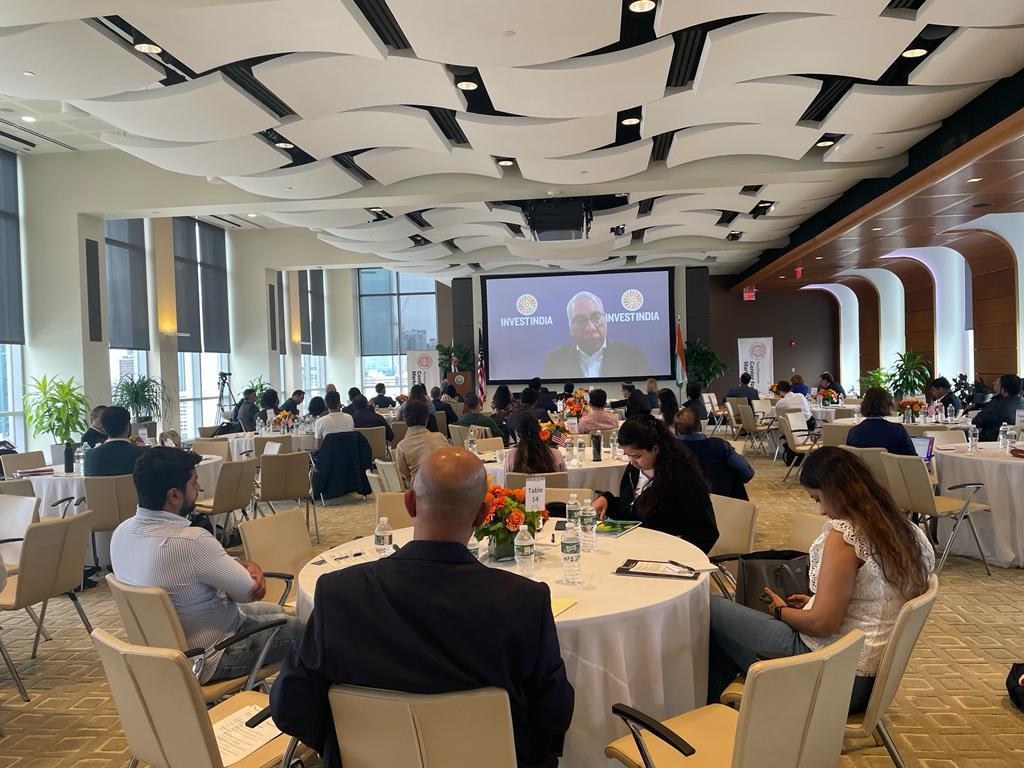 Special Ministerial remarks at the summit was made by Honb’le Minister of Health & Family Welfare, and Chemicals & Fertilizers of India – Dr. Mansukh Mandaviya. He focused his address on India’s recent developments in the India-US health sector, especially the close collaboration in vaccine development. Minister Mandaviya noted that India had vaccinated over 95 % of its adult population distributing 2.19 billion doses, as also supplied COVID vaccines to over 100 countries.
Special Ministerial remarks at the summit was made by Honb’le Minister of Health & Family Welfare, and Chemicals & Fertilizers of India – Dr. Mansukh Mandaviya. He focused his address on India’s recent developments in the India-US health sector, especially the close collaboration in vaccine development. Minister Mandaviya noted that India had vaccinated over 95 % of its adult population distributing 2.19 billion doses, as also supplied COVID vaccines to over 100 countries.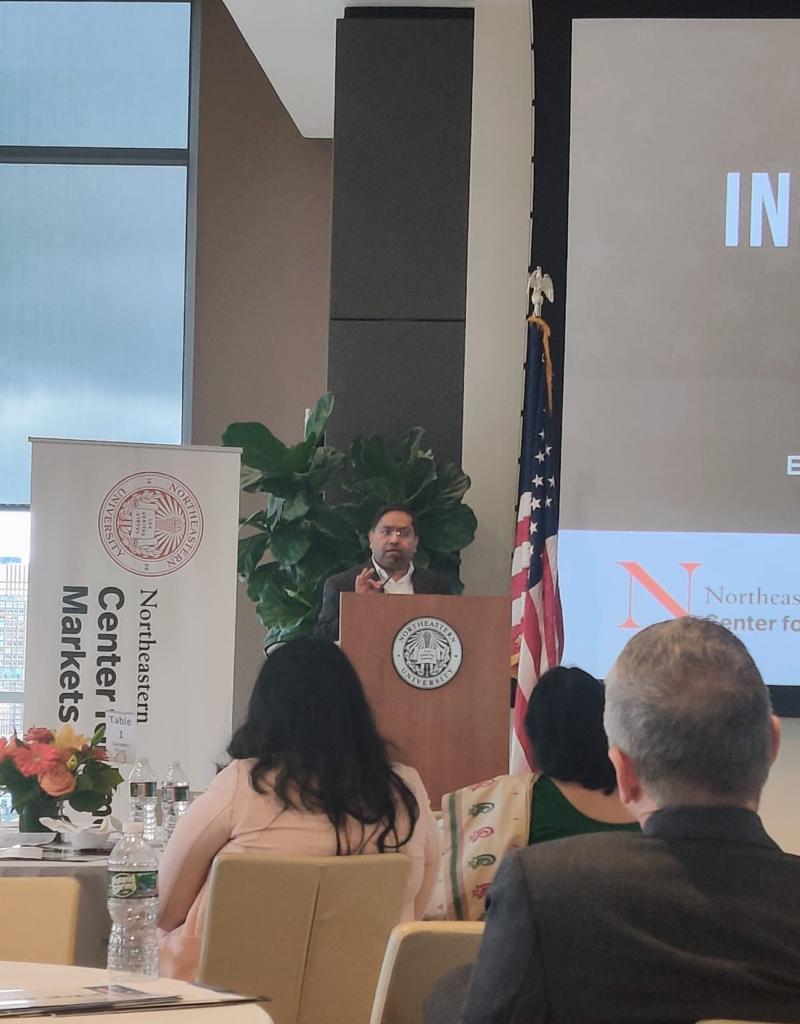 Sumant Sinha, Chairman & CEO, Renew Power, gave a detailed account of the remarkable progress in India in harnessing renewable energy. Renew Power is India’s leading solar and wind energy company with across geography collaboration including with the United States. Mr. Phalgun Kompalli, Co-founder, upGrad, a leading ed-tech company spoke about the growth of digital education and the value company like his bring to the US higher education landscape.
Sumant Sinha, Chairman & CEO, Renew Power, gave a detailed account of the remarkable progress in India in harnessing renewable energy. Renew Power is India’s leading solar and wind energy company with across geography collaboration including with the United States. Mr. Phalgun Kompalli, Co-founder, upGrad, a leading ed-tech company spoke about the growth of digital education and the value company like his bring to the US higher education landscape.  Because the CPI-W is such a broad measure of consumer prices, some have questioned whether the index is the best metric to determine beneficiaries’ needs, the majority of whom are retirees.
Because the CPI-W is such a broad measure of consumer prices, some have questioned whether the index is the best metric to determine beneficiaries’ needs, the majority of whom are retirees. 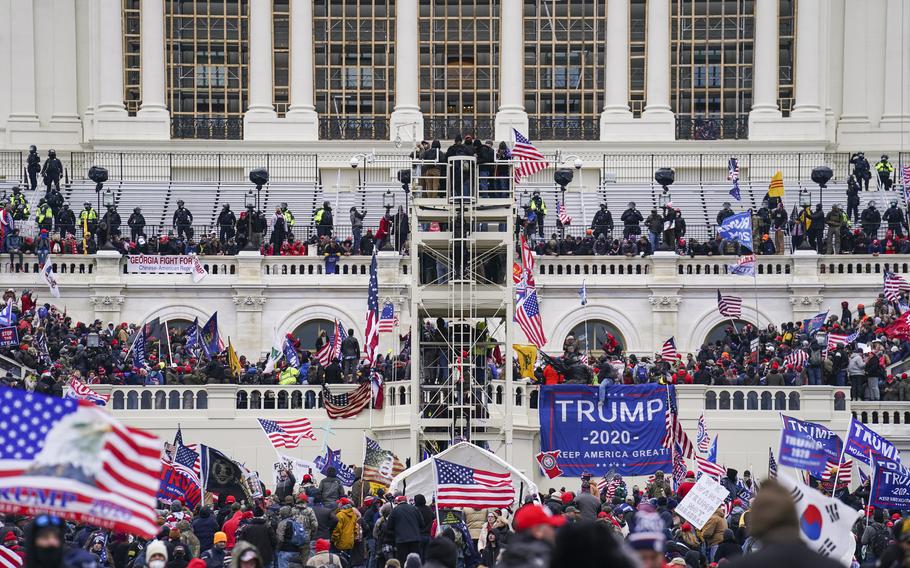 Trump is almost certain to fight the subpoena and decline to testify. On his social media outlet he blasted members for not asking him earlier — though he didn’t say he would have complied — and called the panel “a total BUST.”
Trump is almost certain to fight the subpoena and decline to testify. On his social media outlet he blasted members for not asking him earlier — though he didn’t say he would have complied — and called the panel “a total BUST.”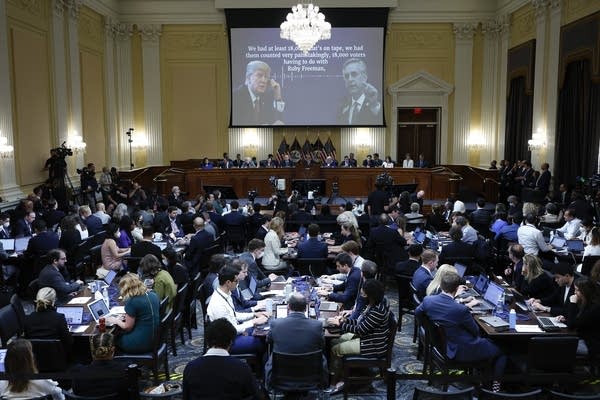 The committee argued in its final hearing before the midterm elections that Trump was directly involved in the bid to overturn the 2020 election, with the panel presenting new evidence that Trump knew he had lost but had a plan to declare victory no matter the election result. The panel also showed
The committee argued in its final hearing before the midterm elections that Trump was directly involved in the bid to overturn the 2020 election, with the panel presenting new evidence that Trump knew he had lost but had a plan to declare victory no matter the election result. The panel also showed 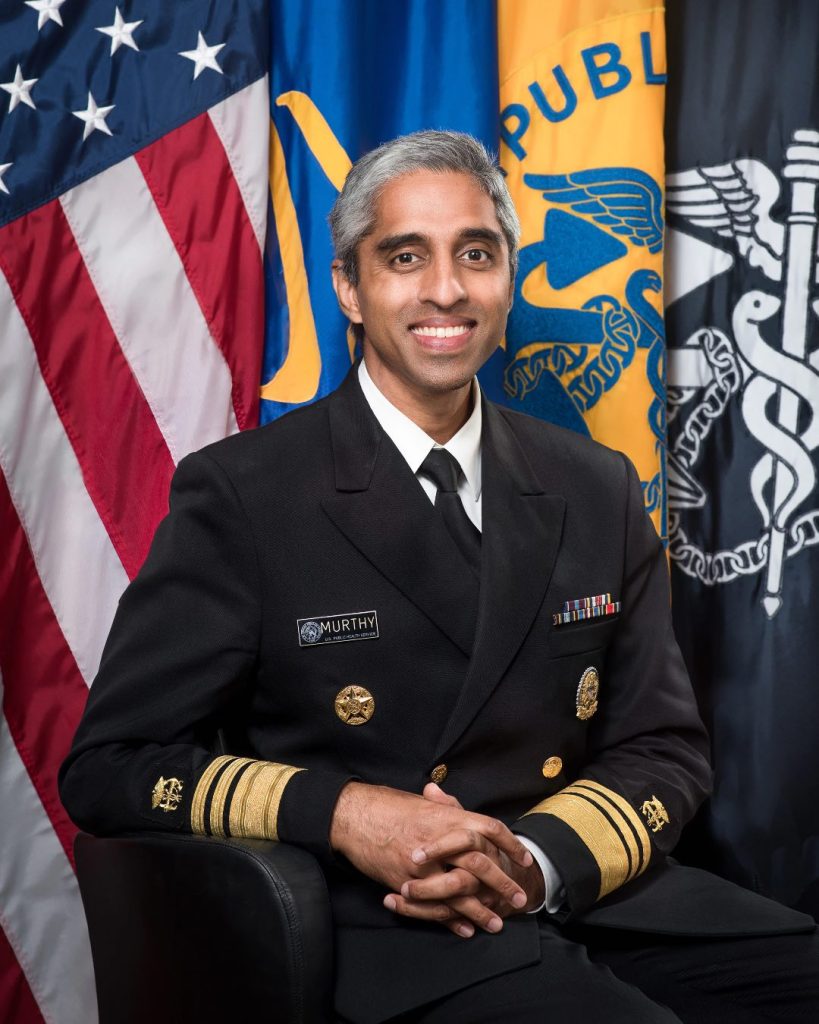 “While serving as the 21st Surgeon General, Dr Murthy is focused on drawing attention to and working across government to address a number of critical public health issues, including the growing proliferation of health misinformation, the ongoing youth mental health crisis, well-being and burnout in the health worker community, and social isolation and loneliness,” said the White House.
“While serving as the 21st Surgeon General, Dr Murthy is focused on drawing attention to and working across government to address a number of critical public health issues, including the growing proliferation of health misinformation, the ongoing youth mental health crisis, well-being and burnout in the health worker community, and social isolation and loneliness,” said the White House.
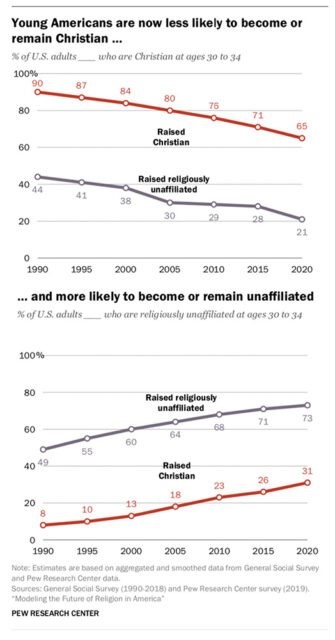 “Young Americans are now less likely to become or remain Christian…and more likely to become of remain unaffiliated” Graphic courtesy of Pew Research Center
“Young Americans are now less likely to become or remain Christian…and more likely to become of remain unaffiliated” Graphic courtesy of Pew Research Center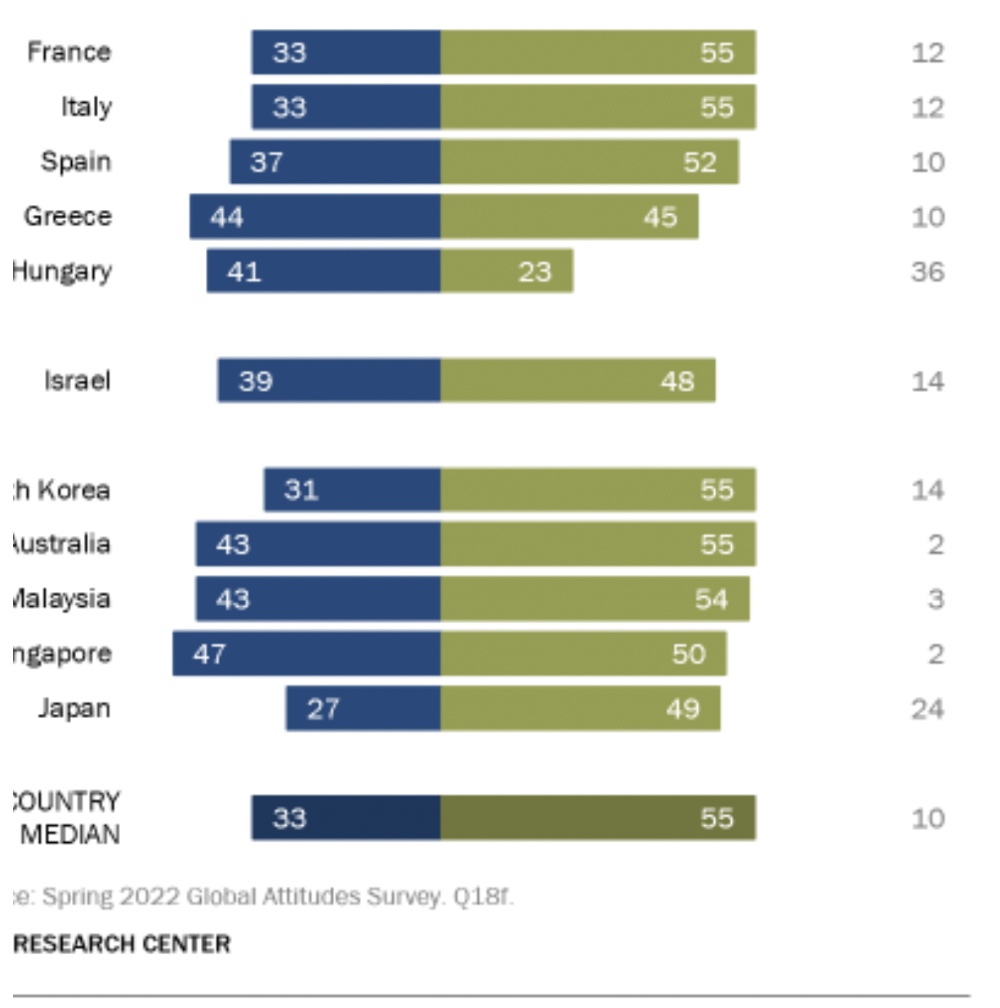 Confidence in Harris is roughly
Confidence in Harris is roughly 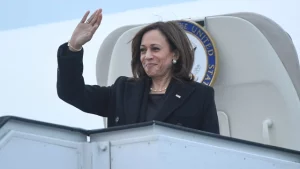 Ideology is also related to views of Harris in some places. In six countries, those who place themselves on the ideological left are significantly more likely than those on the right to have confidence in Harris. Greece is the only country where the reverse is true: 54% of Greeks on the ideological right are confident in Harris, compared with just 32% of those on the left.
Ideology is also related to views of Harris in some places. In six countries, those who place themselves on the ideological left are significantly more likely than those on the right to have confidence in Harris. Greece is the only country where the reverse is true: 54% of Greeks on the ideological right are confident in Harris, compared with just 32% of those on the left.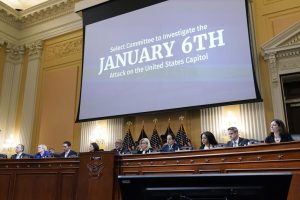 The panel documented how for some 187 minutes, from the time Trump left a rally stage sending his supporters to the Capitol to the time he ultimately appeared in the Rose Garden video that day, nothing could compel the defeated president to act. Instead, he watched the violence unfold on TV.
The panel documented how for some 187 minutes, from the time Trump left a rally stage sending his supporters to the Capitol to the time he ultimately appeared in the Rose Garden video that day, nothing could compel the defeated president to act. Instead, he watched the violence unfold on TV.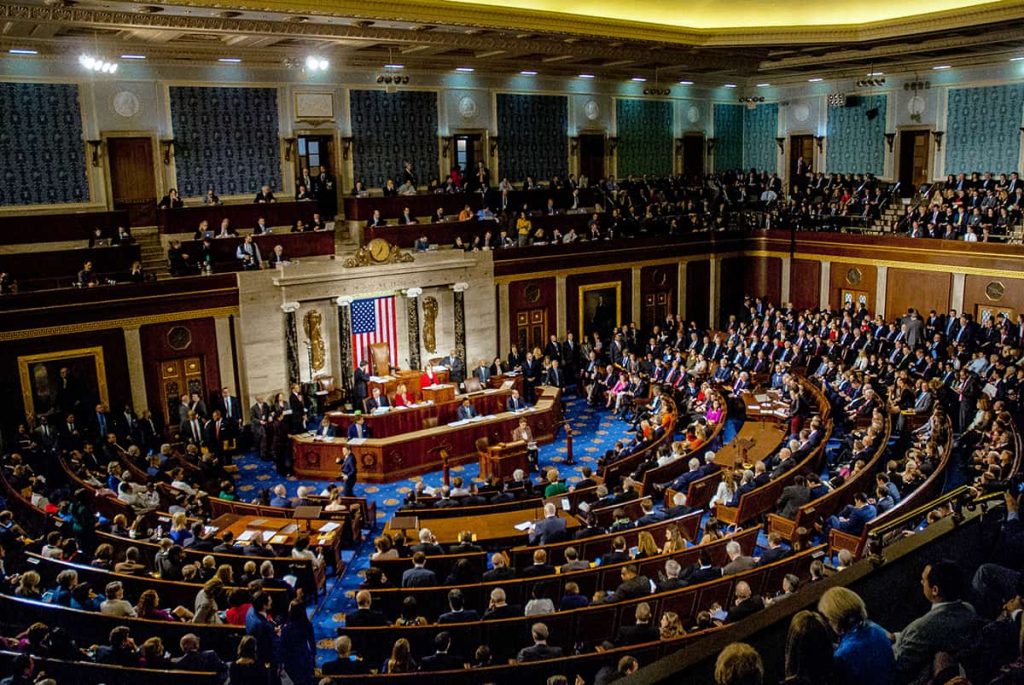 Sam Runyon, a spokesperson for Manchin, said her boss is glad that Democrats have agreed on a prescription drug proposal that they could pass with a simple-majority vote under special budget rules. “Sen. Manchin has long advocated for proposals that would lower prescription drug costs for seniors and his support for this proposal has never been in question. He’s glad that all 50 Democrats agree,” she said.
Sam Runyon, a spokesperson for Manchin, said her boss is glad that Democrats have agreed on a prescription drug proposal that they could pass with a simple-majority vote under special budget rules. “Sen. Manchin has long advocated for proposals that would lower prescription drug costs for seniors and his support for this proposal has never been in question. He’s glad that all 50 Democrats agree,” she said. 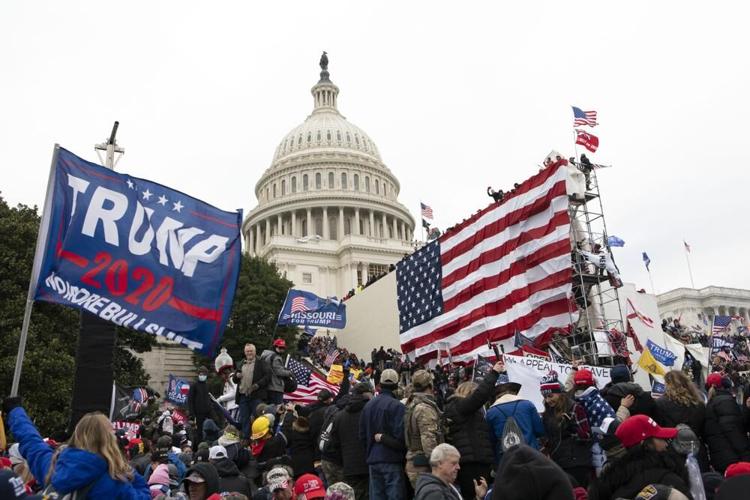 “We will lay out the body of evidence that we have that talks about how the president’s tweet on the wee hours of December 19th of ‘Be there, be wild,’ was a siren call to these folks,” said one panel member, Rep. Stephanie Murphy, D-Fla., over the weekend on “Meet the Press.” In fact, Trump tweeted, “Be there, will be wild!”
“We will lay out the body of evidence that we have that talks about how the president’s tweet on the wee hours of December 19th of ‘Be there, be wild,’ was a siren call to these folks,” said one panel member, Rep. Stephanie Murphy, D-Fla., over the weekend on “Meet the Press.” In fact, Trump tweeted, “Be there, will be wild!” Two factors contribute potently to this assault on the lives of citizens. One, practically anyone over the age of 18 can bear arms in America, even military grade assault rifles, in public. Two, there are enough depressed and mentally deranged citizens in the US who will use the guns to cool their rage. So, we have almost week after week chilling reports of some mass shooting or other in a mall or school or any other crowded place. The USA has become no doubt, a crazy ‘never never land’ where a former President recently organised an armed attack on the Capitol. Could you believe your eyes as they witnessed the violent and shocking visuals on our TV screens with security men running for cover like hunted-down rats? Has killing become a national obsession in the US?
Two factors contribute potently to this assault on the lives of citizens. One, practically anyone over the age of 18 can bear arms in America, even military grade assault rifles, in public. Two, there are enough depressed and mentally deranged citizens in the US who will use the guns to cool their rage. So, we have almost week after week chilling reports of some mass shooting or other in a mall or school or any other crowded place. The USA has become no doubt, a crazy ‘never never land’ where a former President recently organised an armed attack on the Capitol. Could you believe your eyes as they witnessed the violent and shocking visuals on our TV screens with security men running for cover like hunted-down rats? Has killing become a national obsession in the US? 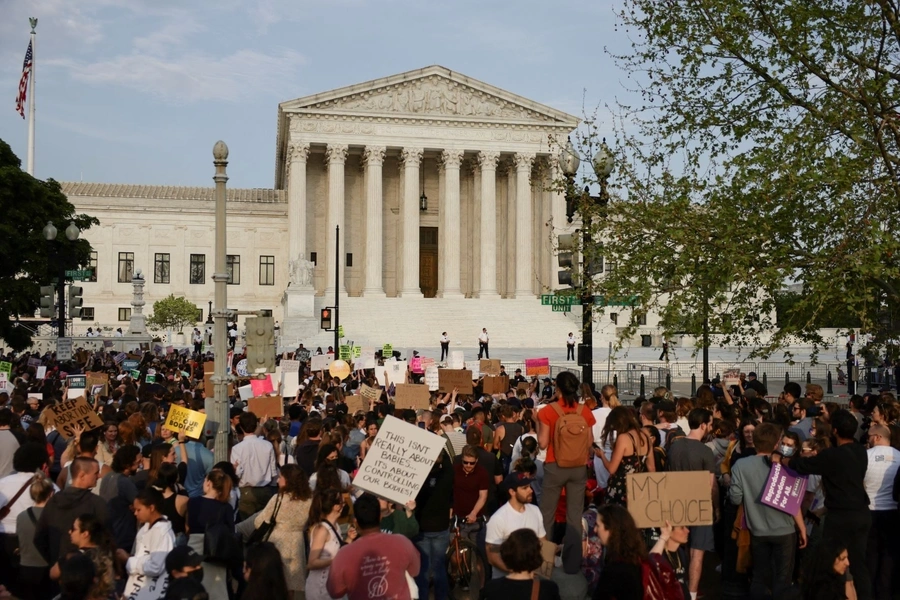 About eight-in-ten Democrats and Democratic-leaning independents (82%) disapprove of the court’s decision, including nearly two-thirds (66%) who strongly disapprove. Most Republicans and Republican leaners (70%) approve of the court’s ruling; 48% strongly approve.
About eight-in-ten Democrats and Democratic-leaning independents (82%) disapprove of the court’s decision, including nearly two-thirds (66%) who strongly disapprove. Most Republicans and Republican leaners (70%) approve of the court’s ruling; 48% strongly approve.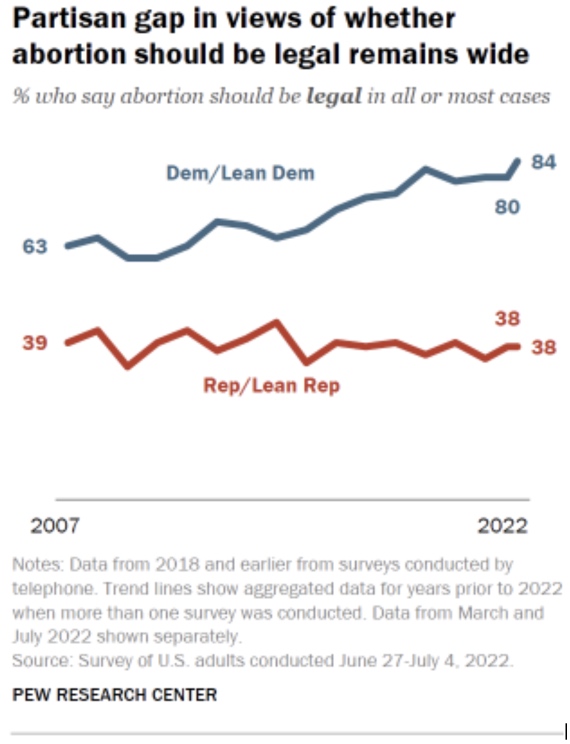 The partisan divide in abortion opinions remains wide. In the new survey, 84% of Democrats say abortion should be legal in all or most cases, compared with 38% of Republicans.
The partisan divide in abortion opinions remains wide. In the new survey, 84% of Democrats say abortion should be legal in all or most cases, compared with 38% of Republicans.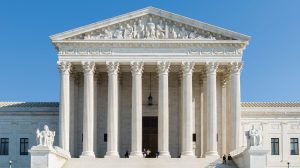 Before a historic series of rulings it was clear the Supreme Court, in its first full term with six conservative justices, was going to move to the right. It just wasn’t clear how far it would go or how fast.
Before a historic series of rulings it was clear the Supreme Court, in its first full term with six conservative justices, was going to move to the right. It just wasn’t clear how far it would go or how fast.  In Washington, where policymakers have been grappling with the fallout from the sudden Taliban takeover of Kabul in August and the scrambled evacuation that followed, the focus has shifted to identifying the mistakes made in the war in Afghanistan. Washington is taking a hard look at where things went wrong — and Pakistan, given its long history with the Taliban, is part of that equation.
In Washington, where policymakers have been grappling with the fallout from the sudden Taliban takeover of Kabul in August and the scrambled evacuation that followed, the focus has shifted to identifying the mistakes made in the war in Afghanistan. Washington is taking a hard look at where things went wrong — and Pakistan, given its long history with the Taliban, is part of that equation.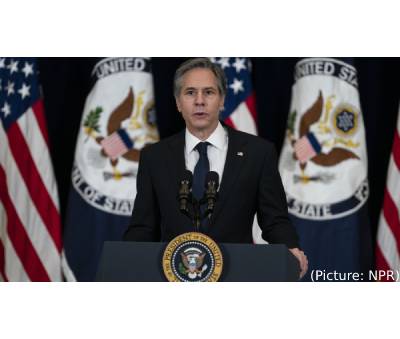 Blinken arrived in India on July 27th to discuss strengthening Indo-Pacific engagement, seen as a counter to China, as well as New Delhi’s recent human rights record and other issues. Blinken’s visit included meetings with Prime Minister Narendra Modi and senior officials on Wednesday, and was held just days after his No. 2 diplomat, Wendy Sherman, was in China for
Blinken arrived in India on July 27th to discuss strengthening Indo-Pacific engagement, seen as a counter to China, as well as New Delhi’s recent human rights record and other issues. Blinken’s visit included meetings with Prime Minister Narendra Modi and senior officials on Wednesday, and was held just days after his No. 2 diplomat, Wendy Sherman, was in China for 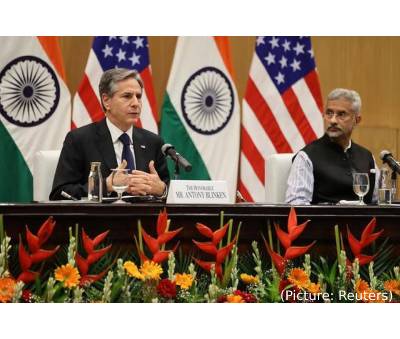 Jaishankar said he made three points to Blinken, including the fact that the “quest for a more perfect union applies as much to the Indian democracy as it does to the American one”.Ahead of Blinken’s visit, India’s
Jaishankar said he made three points to Blinken, including the fact that the “quest for a more perfect union applies as much to the Indian democracy as it does to the American one”.Ahead of Blinken’s visit, India’s 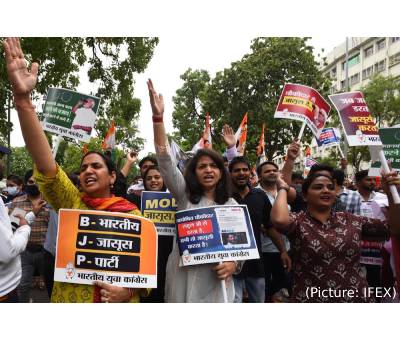 Malinowski, who serves on the House Foreign Affairs and Homeland Security Committees, said NSO Group needs to come clean following
Malinowski, who serves on the House Foreign Affairs and Homeland Security Committees, said NSO Group needs to come clean following  As for individuals monopolizing office, Dr Arpad Bogsch, another US national, held the post of director general of the World Intellectual Property Organization (WIPO) in Geneva for 24 long years (1973-1997). But more recently, however, the professional life span of senior officials in the UN secretariat is mostly five years, with a possible extension for an additional five years. Since money talks, the US has continued to stake its claims for the UNICEF job, primarily as its largest single financial contributor. But that claim also applies to several UN agencies, which depend on voluntary contributions, and where some of the high-ranking positions are largely held by donors or big powers, mostly from Western Europe, or China and Russia.
As for individuals monopolizing office, Dr Arpad Bogsch, another US national, held the post of director general of the World Intellectual Property Organization (WIPO) in Geneva for 24 long years (1973-1997). But more recently, however, the professional life span of senior officials in the UN secretariat is mostly five years, with a possible extension for an additional five years. Since money talks, the US has continued to stake its claims for the UNICEF job, primarily as its largest single financial contributor. But that claim also applies to several UN agencies, which depend on voluntary contributions, and where some of the high-ranking positions are largely held by donors or big powers, mostly from Western Europe, or China and Russia. Samir Sanbar, a former UN assistant secretary-General and head of the Department of Public Information, told IPS the argument over the post of UNICEF Executive Director was the first clash between Boutros-Ghali and Ambassador Albright who otherwise was very friendly, as both were “former professors”. As Boutros-Ghali once quipped: “I may be America’s yes man (as he was described in the Arab press when he was elected secretary-general) but certainly not, yes sir “. Initially, American UNICEF Executive Directors like Henry Labouisse and James Grant proved their value not merely by bringing U.S. funds but by their proven accomplishments, said Sanbar.
Samir Sanbar, a former UN assistant secretary-General and head of the Department of Public Information, told IPS the argument over the post of UNICEF Executive Director was the first clash between Boutros-Ghali and Ambassador Albright who otherwise was very friendly, as both were “former professors”. As Boutros-Ghali once quipped: “I may be America’s yes man (as he was described in the Arab press when he was elected secretary-general) but certainly not, yes sir “. Initially, American UNICEF Executive Directors like Henry Labouisse and James Grant proved their value not merely by bringing U.S. funds but by their proven accomplishments, said Sanbar.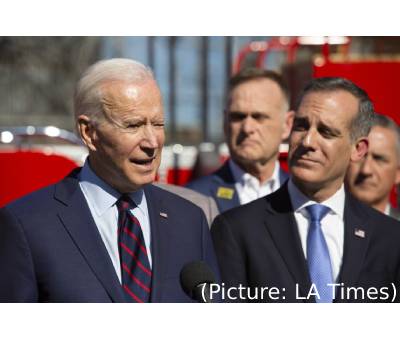 On accepting the nomination Garcetti posted a statement on the city’s website: “I love Los Angeles and will always be an Angeleno. I want you to know that every day I am your mayor, I will continue to lead this city like it is my first day on the job, with passion, focus, and determination. I have committed my life to service –– as an activist, as a teacher, as a naval officer, as a public servant and, if confirmed, next as an ambassador. Part of that commitment means that when your nation calls, you answer that call. And should I be confirmed, I’ll bring this same energy, commitment, and love for this city to my new role, and will forge partnerships and connections that will help Los Angeles.”
On accepting the nomination Garcetti posted a statement on the city’s website: “I love Los Angeles and will always be an Angeleno. I want you to know that every day I am your mayor, I will continue to lead this city like it is my first day on the job, with passion, focus, and determination. I have committed my life to service –– as an activist, as a teacher, as a naval officer, as a public servant and, if confirmed, next as an ambassador. Part of that commitment means that when your nation calls, you answer that call. And should I be confirmed, I’ll bring this same energy, commitment, and love for this city to my new role, and will forge partnerships and connections that will help Los Angeles.” In an op-ed for the Washington Post published on Saturday, the U.S. President promised to shore up Washington’s “democratic alliances” in the face of multiple crises and mounting threats from Moscow and Beijing. The U.S. will stand with its European allies against Russia, President Joe Biden has promised ahead of the first face-to-face meeting with Vladimir Putin.Most recent American presidents have selected North American neighbors for their first cross-border trips, though former President Donald Trump, whose penchant for unilateral action and open skepticism of the NATO alliance unsettled American allies, made his first overseas stop in Riyadh, Saudi Arabia. For Biden, the first trip is meant to turn the page from Trump’s approach to alliances.
In an op-ed for the Washington Post published on Saturday, the U.S. President promised to shore up Washington’s “democratic alliances” in the face of multiple crises and mounting threats from Moscow and Beijing. The U.S. will stand with its European allies against Russia, President Joe Biden has promised ahead of the first face-to-face meeting with Vladimir Putin.Most recent American presidents have selected North American neighbors for their first cross-border trips, though former President Donald Trump, whose penchant for unilateral action and open skepticism of the NATO alliance unsettled American allies, made his first overseas stop in Riyadh, Saudi Arabia. For Biden, the first trip is meant to turn the page from Trump’s approach to alliances.